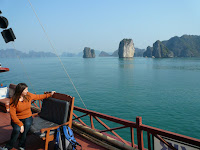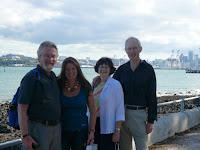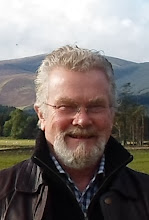
Its been a busy 2009 so far – here is a note of our ‘mini’ world tour! We had nearly 3 wonderful months from Jan to March 2009.

We also visited the Chinese New Year celebrations with James and had a great time visiting restaurants and places in Singapore. Many of these places still retain the atmosphere of the early 20th century, notably, the 'shop houses' 
Our pictures of Singapore are here:
Singapore with James at New Year 2009
Singapore - more places & scenes
From Singapore we made a very memorable trip to Hanoi and the nearby Ha Long Bay. Hanoi is a bustling city which still retains some of the charm of the steet chaos and shops from days gone by. Ha Long Bay is a World Heritage Site 
After leaving Hanoi we travelled to Cambodia and visited the temples of Angkor Wat.
This was a lifetime ambition of mine, having first read about them in the National Geographical Magazine when I was a boy in about 1960! These temples were all built over many square miles in the jungle in the period of about 850 AD to 1400 AD.
After this time they fell into disuse and gradually the jungle took over. They remained hidden until a French explorer in Henri Mouhot rediscovered & popularised them. These temples are fascinating and I can only suggest you go there and see them.
Here is a selection of our photos Cambodia
Our guide was also a fascinating person and I have written about him on this blog. He also took us to the floating village on the Tonle Sap lake in Cambodia. The lake which take a who day to navigate by fast power boat along it's length connects with the Mekong further down the country. It is an enormous lake and at one end there is there is this village, entirely floating on bamboo floats and other more modern platforms. These people live on the lake for their whole life; there are schools, community centres, shops, etc.
We returned to Singapore and then made a visit to the island of Lombok and had a very pleasant week at a super hotel on the beach at Senggigi. 
The next leg of our journey took us to New Zealand where we spent nearly a month travelling through the country in a campervan! We really enjoyed travelling this way and nearly a month later we were still talking to each other! 
New Zealand is a beautiful country with stunning 360 degree views and wonderful landscapes. It is hard to explain or capture it on camera. 
We didn’t manage to travel throughout the North and South Island completely and I should say that the North Island is beautiful too. One of the examples of this beauty is Hahei Beach on the west coast facing the Pacific. I swam every morning and afternoon in this crystal clear water. 
We have taken lots of photographs and some of these are on my Facebook. Here is a selection:Vic's NZ Photos.I have also put some on Panoramio so you can see the places we went to.
The food was excellent everywhere – we were eating their home grown avocados; buying grapes on the roadside and eating green lipped mussels so fresh they just melted in your mouth.
We certainly want to go back but it is a long way to go. Our month wasn’t long enough. We should have allowed three months so we could take in some of the wonderful walks and dwell longer at some of the beautiful places. 
We went on from Auckland to Sydney and visited Carol’s friends Duncan & Gail, staying at their lovely home. 



Here is a selection of our photos: Sydney!
